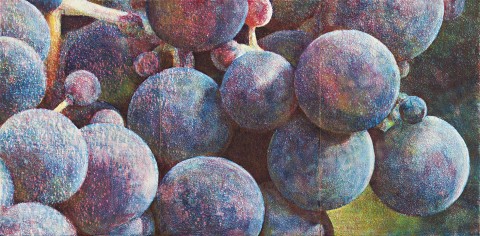UNTITLED (PURPLE GRAPES), 1998
TIM MAGUIRE
monotype on three sheets of Arches paper
147.5 x 300.0 cm
Tolarno Galleries, Melbourne
Private collection, Sydney, acquired from the above in 1998
Sets and Series, Tolarno Galleries, Melbourne, 14 March – 11 April 1998
Murray Cree, L., (ed.), Tim Maguire, Piper Press, Sydney, 2007, p. 117 (illus. in installation view)
‘The goal for a serious painter today is to make work that is simultaneously embedded in the tradition of painting whilst engaging with the contemporary world. This Maguire does’.1
With its sheer beauty, cinematic grandeur and themes of luscious abundance, Untitled (Purple Grapes), 1998 offers a stunning example of the sensuous magnified fruit and floral bloom paintings for which Tim Maguire has become internationally renowned. Though resolutely contemporary in their beguiling surrealism and technical innovation, such works nevertheless draw inspiration from the past and specifically 17th century Flemish still life painting – those opulent depictions of fruit, flowers and game all purposefully arranged to convey powerful moral lessons about the emptiness of worldly possessions, the fleeting nature of beauty and the transience of earthly life. Evoking the Dutch vanitas tradition, Maguire similarly embraces a ‘kind of metaphoric realism’ in his work, seducing the viewer with the illusionism of his surfaces while simultaneously eliciting meaning beyond the exact realism of his subject. Discussing the motif of the berries which features here (and pervades his oeuvre), Maguire illuminates, ‘… in one bunch you have berries that are spherical and perfect, glistening, shiny and others that are starting to go bad ... With such a botanical subject matter I'm interested in allegorical possibilities arising out of the life cycle, the contrast of perfect beauty with decay, its seductive allure as opposed to something past its sell-by date’.2
However, to construe Maguire’s work purely within the Flemish still life tradition would be to ignore his enduring preoccupation with the physical process of painting and in particular, the complex dichotomy between production and reproduction, between the painterly and the photographic. As one commentator suggests, ‘… catching the moment when the magic of the image collapses into the materiality of the brushstroke, the real subject of his paintings is painting itself’.3 Such would also seem to accord with the artist’s own recollection of his relationship to the source of inspiration; ‘… the further away I got from the original image, the more scope there was for painterliness and asserting the materiality of the process, which was the whole point of the exercise’.4 In the present work, Maguire experiments with the accrual of deftly-painted, chromatically separated layers through the monotype printing technique to create an illusion of texture which – rather than preserve the thoughts and gestures of the artist – remains remarkably detached, even self-effacing. Such ambiguity is heightened further by the extraordinary scale and dramatic cropping of the image in a manner recalling photographic processes – the viburnum berries are both instantly recognisable yet removed from their fleshy actuality to become almost abstractions. With their notions of impending decay, distortion of scale and scattered surface imperfections, Maguire’s sumptuous fruit and floral images such as the present challenge the viewer to delve beyond the mesmerising beauty of his surfaces and glean new perspective on the whole. As the artist himself muses, ‘My paintings, as much as they expose themselves, their process and so on, are rather flat, shiny and a bit repellent. The imagery is unnatural ... the subject might be about nature but they're not really natural’.5
1. Godfrey, T., 'Skin, Light and Beauty' in Murray Cree, L. (ed.) Tim Maguire, Piper Press, Sydney, 2007, p. 28
2. Maguire, ibid., p. 134
3. ibid., dustjacket
4. Maguire, T., cited in “What is it 'as it really is'? Tim Maguire in conversation with Jonathan Watkins”, ibid., p. 72
5. Maguire, T., ibid., p. 134
VERONICA ANGELATOS
